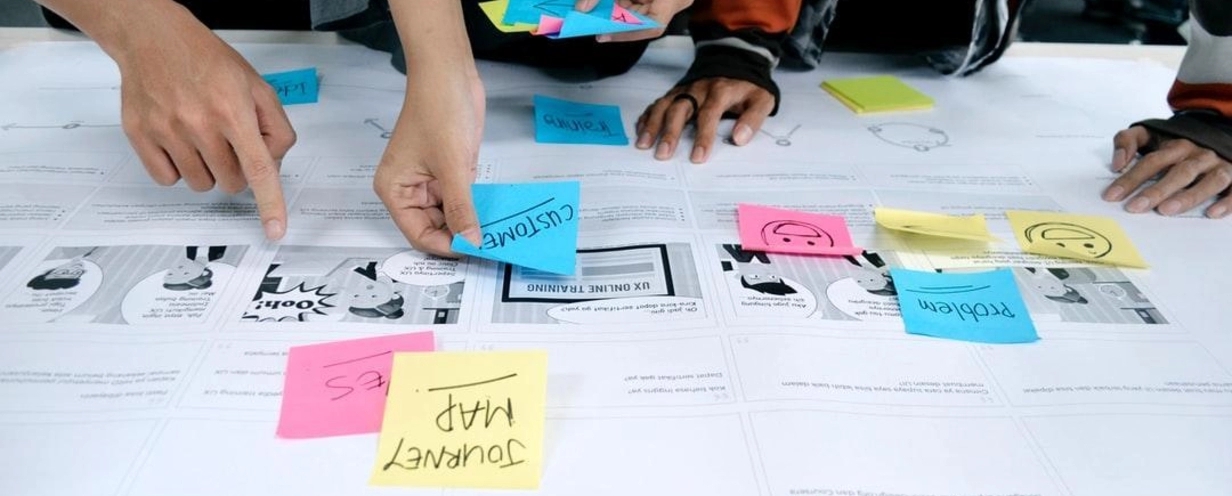
UX strategy: the foundation of a successful product

It's no secret that a comprehensive business strategy is vital to an organization's success. Market analysis, financial projections, and marketing and sales strategy are all key components. However, with the digital space becoming more crowded with new businesses every year, one aspect can't be overlooked: user experience (UX).
As competition for user attention grows, consumers have more choices than ever. To attract and retain customers, organizations have to develop a user-centered experience. This means addressing user pain points and making the experience engaging and easy to use while quickly meeting their needs. But how do you achieve this? A well-crafted UX strategy.
What is a UX strategy?
UX transcends mere aesthetics and delves into what makes a product resonate with its users. A UX strategy is a plan that outlines how to create a product or service that provides meaningful and delightful experiences for users.
This plan bridges the user-centered approach of design teams and the goal-oriented nature of a business strategy.
The meaning of the term “UX strategy” can range from covering the customer journey of a single product or feature, to becoming the customer experience strategy of an entire organization. Regardless of scope, a well-articulated UX strategy provides a product roadmap that integrates your organization's product vision, brand identity, design, function, and usability under one unified narrative.
Why a UX strategy is important
Modern consumers expect speed and ease of use. By leveraging good UX design, you can:
- Improve user satisfaction and increase engagement by eliminating problems caused by difficult or confusing-to-use products
- Improve conversion rates by simplifying the customer journey from curiosity to purchase
- Enhance brand perception, shaping your organization's image and creating positive interactions with consumers
- Gain competitive advantage by differentiating your products from competitors and offering a user-centric experience
Simply put, a UX strategy guides how you’ll create and implement your UX design processes.
UX design is a combination of art and science. Though organizations can utilize quantitative data—information that can be understood through hard numbers—an equally important type of information is a little more subjective: qualitative data.
This information is observed by UX researchers who understand how to interview users and watch them interact with a product or service. Then, they can derive what's working for the user and what's not.
Traditionally, it's been hard to tie design decisions directly to business results, and that's where a solid UX strategy helps. A well-communicated UX strategy makes it easy to understand the tangible benefits of investing in UX research and design. It connects the dots between user satisfaction and business outcomes, such as increased sales, customer retention, and brand loyalty.
Translating user experiences into measurable impacts on business performance and goals makes a UX strategy a key investment that drives growth.
Beyond convincing leadership, a UX strategy also provides the following benefits:
Creating cross-team alignment
Each team within an organization has its own objectives and ways of getting the job done. Sometimes, matching these different methods and objectives with an organization's overall goals presents challenges.
A UX strategy is a common reference point that aligns different teams around a shared vision. It ensures that designers, developers, marketers, and product managers all pull in the same direction, fostering a cohesive approach to product and service development. This alignment is critical in the final product, reflecting the collective expertise and efforts of the entire organization.
Fostering a user-centered culture
By placing the user's needs and experiences at the core of its philosophy, a UX strategy cultivates a user-centric mentality across an organization. This cultural shift solidifies user considerations as a part of every conversation and decision. It drives teams to consider the impact of their decisions on the user's satisfaction and engagement.
Guiding decision-making
The UX design process involves a myriad of choices. A UX strategy provides a framework that guides these decisions, making them deliberate and consistent with your overall UX goals. It acts as a product roadmap that navigates teams through complex design landscapes, helping to prioritize features, solve user problems effectively, and enhance the overall customer journey.
Reducing costly redesigns
Without a clear user experience strategy, UX design can become a game of guesswork. This often leads to underperformance that requires expensive and time-consuming reworks. A UX strategy mitigates this risk by establishing clear goals, success metrics, and user research processes upfront. By getting it right the first time, organizations can avoid the costly cycle of redesigning and redeveloping user interfaces and flows, which can also lead to lost revenue and damaged brand reputation.
5 key characteristics of a good UX strategy
Effective UX strategies vary depending on your specific objectives, industry, and needs. However, there are a few overall characteristics all organizations should strive for when designing a UX strategy.
1. An understanding of the user's perspective
An effective UX strategy hinges on thorough research of the user's perspective. This research helps you structure your plan and define priorities. Insights from UX research build an empathetic approach and inform the creation of experiences tailored to user needs and preferences. This involves gathering qualitative and quantitative data, such as:
- Usability testing and feedback
- User interviews with trusted experts, such as those at UserTesting
- Analytics data like session duration and user flow
- A/B testing
- Behavioral metrics like time on task and task conversion rate
- Open-ended survey responses
Having the right research tool is an important component in building user empathy. In order to quickly make customer-centric decisions, organizations benefit most from a comprehensive research solution for human insights.
2. An overall vision
Creating an overall vision is the first step on the path to a good UX strategy. It sets the direction and aspirations for the user experience and ensures that every aspect of the user experience strategy aligns with your objectives. To establish a UX vision that is both meaningful and strategic, begin with your core business goals.
From there, define the problems you want to solve and the emotional responses your product aims to evoke in users. Whether the goal is to empower users, provide a sense of ease, instill confidence, or simply bring delight during their interaction, these target emotions will guide the design philosophy. Alongside this, identify the crucial interactions—moments within the customer journey that are significant and have the greatest impact on users. Determining the quality and nature of these experiences is a strategic step that helps the product meet and even exceed user expectations.
Then, create a vision statement to define all this information and distill the experience into a direct philosophy. For example:
"We aim to be the go-to resource for financial advice by putting users at ease when searching for answers to challenging financial questions. Our service will provide easy-to-understand financial advice to the most frequently asked questions surrounding saving, spending, investing, and retirement planning, offering actionable steps for users to reach their desired financial goals."
3. Clear step-by-step plan
Creating a clear step-by-step plan transforms your goals and user research into actionable steps toward a final deliverable that your customers find uniquely valuable.
When creating a plan, be sure to include:
- Deadlines for each step's completion
- Team members involved
- User needs and preferences for each step of the user journey
- Specific goals that the step will achieve
As you create and follow a UX strategy, you'll find it helps you:
- Prioritize tasks effectively
- Communicate clearly with those involved in each step
- Measure progress
- Manage complex objectives
- Maintain consistency
- Enhance collaboration
4. Success metrics
Once you've outlined and followed the steps of your user experience strategy, you'll need a way to measure its success. These metrics help track your user experience's success and provide actionable insights that can drive continuous improvement. Here are several common metrics you can use to measure the success of your UX strategy:
- Task success rate: A percentage of correctly completed tasks by users that reflects how effectively a product enables a user to achieve their goals
- Error rate: The frequency of errors users make, such as incorrect entries or failed attempts, which can indicate usability issues
- Page views: The number of pages viewed per session, which suggests the level of user interest
- Net promoter score (NPS): A metric that gauges the likelihood of users to recommend the product to others
- Customer satisfaction score (CSAT): A measure of how satisfied users are with the product, usually obtained through surveys with questions on satisfaction levels
- Click-through rate (CTR): The ratio of users who click on a specific link compared to the number of total users who view a page
- Click maps: Visual data representing where users click, touch, and scroll, indicating which areas of the page attract the most attention
- Interactive path flows (IPFs): Patterns in the paths users take through a product, identifying common journeys and potential trouble spots
- Load time: The time it takes for a page or app to become fully interactive
Success metrics should be tailored to the specific objectives of your UX strategy and organization.
For example, if your goal is to improve your ease of use, your task success rate and error rate might be more important than other metrics. Defining these key metrics while developing your UX strategy won't just help you in the beginning process; they will become vital as more users engage with your product and you need to refine your user experience.
5. Flexibility and scalability
A good UX strategy doesn't just focus on the present needs of users. It also anticipates and adapts to future changes. Flexibility in a UX strategy acknowledges that both user needs and market conditions are in a constant state of flux. It also promotes scalability and anticipates your product's growth before it happens.
For example, as users' familiarity with a product increases, their expectations may shift, requiring adjustments to your user experience to accommodate these new demands. Similarly, market dynamics can change rapidly with the introduction of new competitors or technologies, and a flexible UX strategy can pivot to incorporate these without losing its core value proposition.
A scalable UX strategy plans for increasing traffic, more diverse user interactions, and new features or content. It’s about creating a design that not only works well for a small number of users but can also maintain its integrity and performance at a larger scale. Incorporating this foresight into your UX strategy helps your organization prepare for a larger national or even international audience.
How is a UX strategy communicated, implemented, and delivered?
In addition to careful planning, developing a UX strategy involves effective communication, diligent implementation, and strategic delivery. These components are crucial for transforming a UX vision into a tangible reality.
Communication
Before implementing a UX strategy, all stakeholders must understand and be on board for the process ahead. Effective communication means presenting a clear and persuasive narrative that links your organization's goals with your users' expectations and needs.
To effectively communicate your UX strategy, tools like customer journey maps help everyone visualize the strategy and understand the necessary steps for an ideal user experience. This is also an opportunity to identify any sticking points where users may have difficulty and mitigate these issues before they reach users.
Implementation
The implementation phase requires teams to work together to turn the UX strategy into reality. Here are some steps to help you with implementation:
- Create cross-functional alignment between your UX/UI designers, developers, product managers, content strategists, and stakeholders. Make sure all necessary parties understand the mission.
- Create a detailed process or cadence that outlines each step of the implementation. This might include research phases, design and development sprints, user testing periods, and review cycles.
- Develop a design system with a collection of reusable components, design standards, and guidelines that ensure consistency across the product.
- Regularly test the product with users to validate assumptions and ensure the UX meets their needs.
- Be prepared to adjust the strategy based on ongoing user feedback.
Successful implementation of your UX strategy requires attention to detail, a commitment to customer-centric design, and a willingness to evolve based on new information and what works best for your users.
Delivery
The delivery of a UX strategy is the phase where the strategic planning, design, and development work becomes a lived experience for users. A phased rollout, such as a beta release, allows for additional testing and identifying unforeseen issues. It also allows you to gather user feedback in a manageable way before a full-scale launch.
During your gradual delivery, have feedback mechanisms in place and use analytics to understand how users interact with your product. Track specific qualitative and quantitative metrics that you established as part of your developing your UX strategy.
After identifying and implementing any needed changes, conduct a post-launch review with the project team to evaluate the success of the delivery against the original UX strategy goals. This will help you adjust any future strategies to help increase the likelihood of early success.
Who benefits from a winning UX strategy?
The benefits of a winning UX strategy ripple out from an organization to many people. These include:
- Customers: Users are the direct beneficiaries of a good UX strategy. When the user experience is intuitive, efficient, and satisfying, it enhances their overall satisfaction, and they don't have to look for another product to fulfill their needs.
- Designers: For designers, a good UX strategy acts as a guiding light that informs their design decisions. It provides a clear understanding of the users' needs and your organization's business goals, allowing designers to create with purpose and direction instead of finding their way in the dark.
- Marketing and sales teams: Good products are easier to sell, and a solid user experience is a strong selling point that distinguishes a product in a crowded market. A winning UX strategy increases the likelihood of marketing and sales teams having a great product to sell, which makes their jobs much easier.
- Product managers: A good UX strategy helps product managers manage the product roadmap more effectively and make informed decisions regarding the product's direction, providing a framework for measuring product success throughout the process.
- Compliance teams: A good UX strategy that incorporates compliance into the design process, saving compliance teams time and effort when it comes to checking that a new product meets industry standards and regulations.
- Stakeholders: It’s important to have assurance that a product will not only succeed at market, but contribute to business goals and adhere to your organization’s alignment. A good UX strategy helps by presenting a customer-centric approach that increases the chances of a product's success.
Develop a UX strategy that attracts and retains users with UserTesting
User experience is a vital component of the success of digital products, but knowing exactly how to craft a winning UX strategy can be difficult. UserTesting helps organizations like yours understand what users need. Our human insight platform lets you get close to users as they engage with your products, designs, apps, processes, concepts, and brand. We also help you analyze and leverage user research to develop a successful UX strategy and launch a product that aligns with your business goals.

Watch a demo
See how easy it is to get fast feedback on a website, prototype, design, or more in this demo.





